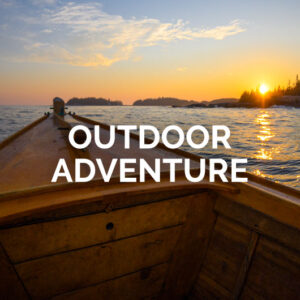Fat Biking in MidCoast Maine
The What and Where of Winter Fatbiking
“What’s that?!” I shout to Christine, just five feet in front of me but inaudible over the whirring of giant rubber tires on crunchy snow. She slows to a stop, and my disc brakes squeal slightly before silencing as I come to a halt next to her.
“Are you slipping at all on the climbs?” she asks me, looking over her shoulder, then glancing down at the back tire of her bike.
“Only briefly,” I reply, “I found that keeping my weight back over the tire really helped.” I shrug, we were both figuring this out together, for neither of us have ever fat biked before.
With that, we resume our progress through the forest, or at least Christine does. I, naively, had left my bike in a hard gear, and rather than gingerly easing the bike into forward momentum (as I would later find is preferable), I stomped on the pedal with all my might, causing the rear tire to spin wildly, digging a hole and sending snow flying. Whoops.
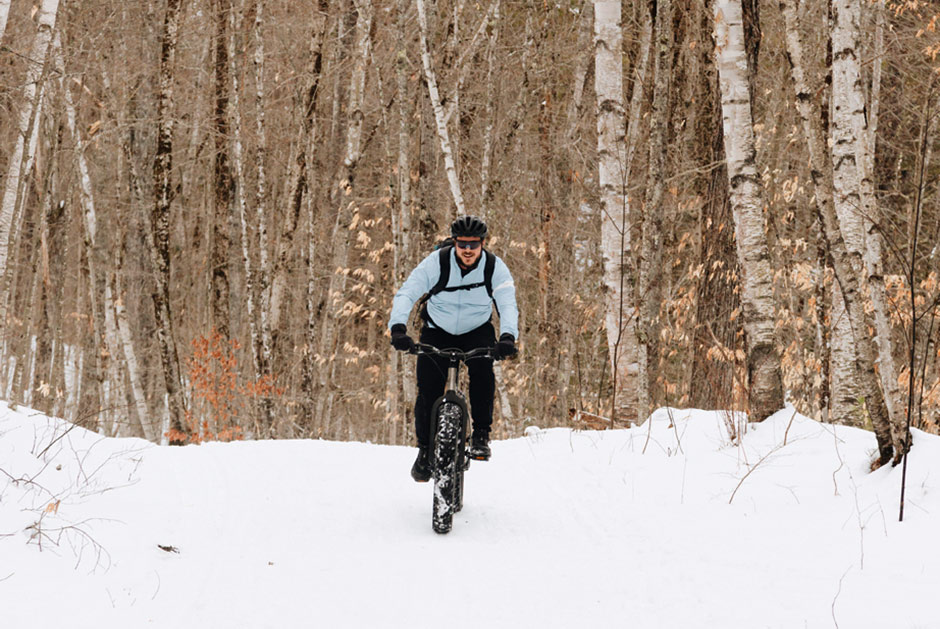
Fat biking, like mountain biking before it, began in the workshops and garages of tinkerers, creating bikes to suit the terrain near them—namely the snow of Alaska and the sand of New Mexico. In fact, the earliest iterations that might resemble a modern fat bike were created for the 1988 Iditabike—a 200-mile race along the first stretch of the famed Iditarod trail—and were created using custom frames and pairs of standard mountain bike wheels welded together. By 1999 a more standardized oversize tire became available, and between 2005 and 2010 fat bikes began to transition from being niche Frankenstein projects built in a garage into mainstream bikes, sold by international brands. Today they are so popular you’d be hard-pressed to head out on a trail in Maine where fat bikes are allowed and not see the tracks of one having come through before you.
As such, Christine and I, avid road cyclists in the warmer months, figured it was about time we gave this sport a try! We headed up to Bath Cycle & Ski to pick up our rentals, a pair of titanium Carver fat bikes. Carver may be the adult iteration of the custom garage-built bikes from the early days of the sport. Designed right there in Bath (well, Woolwich actually), the bikes are welded overseas before being built up here in Maine to the specs of the buyer. Each of our bikes shared a similar drivetrain, but otherwise the components, tires, and even handlebar and front fork were unique. The end result out on the trails were two bikes that handled differently.
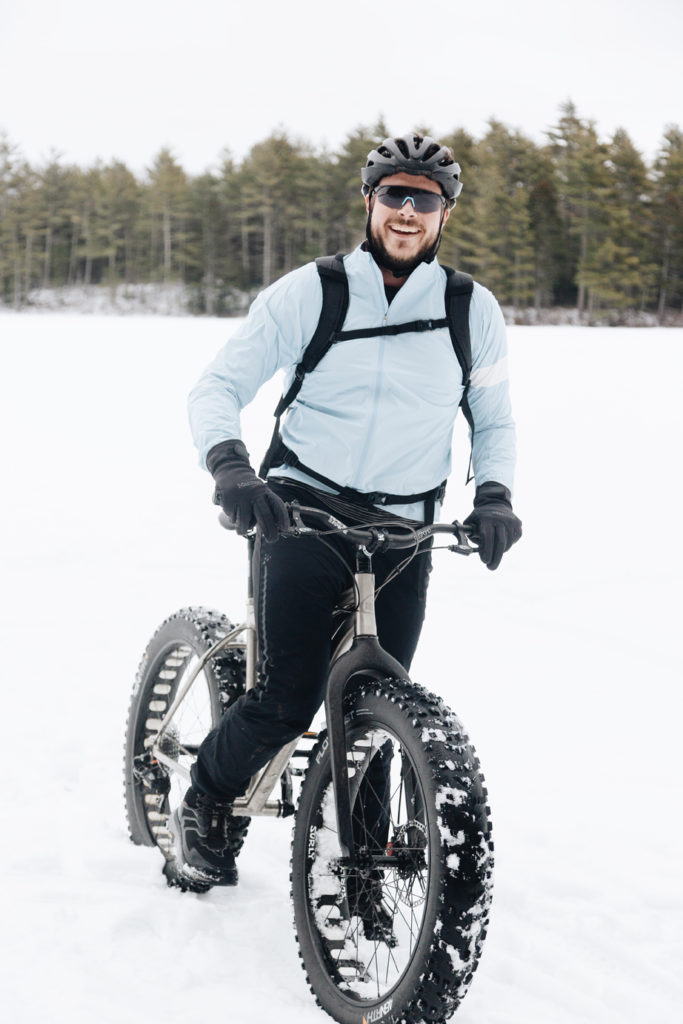
Mine, with smaller tires (we are still talking something 4” or bigger here, certainly not small!) called for a slightly higher tire pressure, around 8-10psi which made for faster grippy riding on the morning’s harder packed snow. Christine’s bike was running at an even lower tire pressure, and it began to really excel as the day warmed to a balmy 37ºF and the snow began to get loose and slushy. I slipped around on our last mile or two, while she maintained traction.
The folks at Bath Cycle and Ski were gracious in getting the bikes sized properly for us, and getting them loaded up on my car. Now came the hard part—figuring out which trail system to ride on today! Maine’s midcoast is blessed with a plethora of trails—in Bath alone there are two trail systems that allow fat biking. We opted however for the Hidden Valley Nature Center near Alna. With 25 miles of trails, many of those groomed for skiing and fat biking, on rolling terrain set next to Little Dyer Pond, it made the ideal spot to learn.
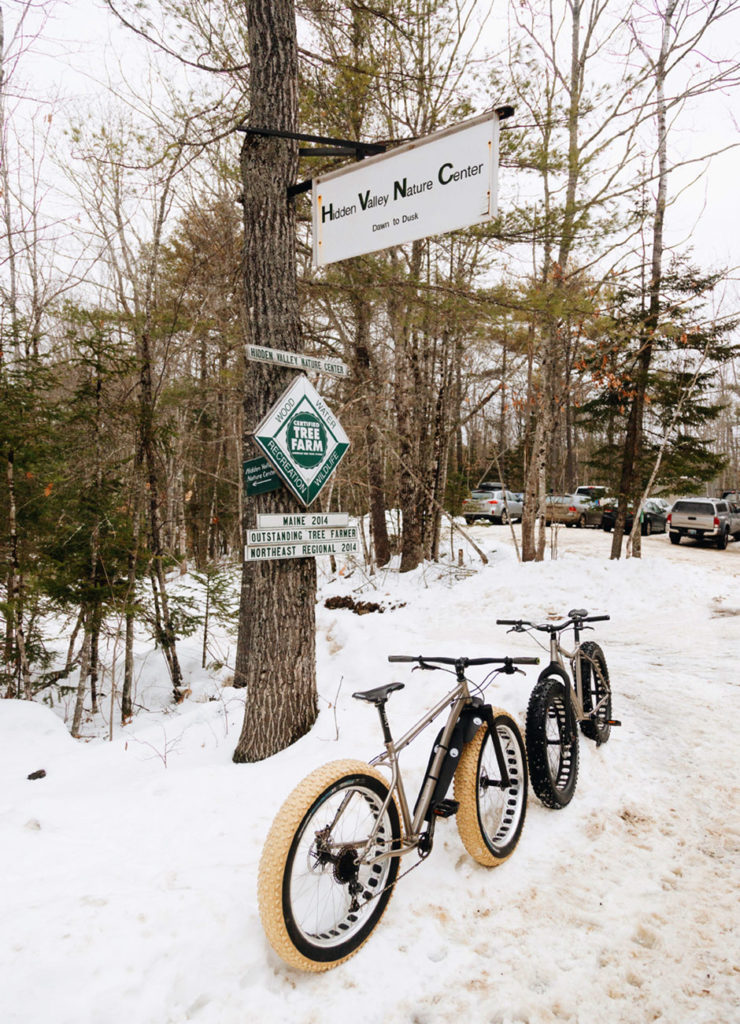
After a morning loop out to one of the huts in Hidden Valley Nature Center—they are run by the Midcoast Conservancy and available for overnight stays—we warmed up and grabbed a bite to eat at ‘The Barn’, a central hub in their trail network with a large pavilion, and a much-appreciated wood stove!
“Another loop?” I ask after we’ve both warmed sufficiently.
We hop back on the bikes and head south this time, taking in the more formidable Sugar Ridge and Couch Hill. Here, as the gradients rise, the differences between fat bikes and the bikes we’re more used to are most striking. First of all, the speed is much lower, but as we learned, the technique required is different as well. Rather than standing up out of the saddle and attacking the climb, overcoming it with raw power, it was a slow but steady grind, with as fast a cadence as we could manage that would get the bike up the steep slopes. At times it almost seemed as if we were crawling up the hill rather than rolling, and I questioned the efficiency of the device between my legs.
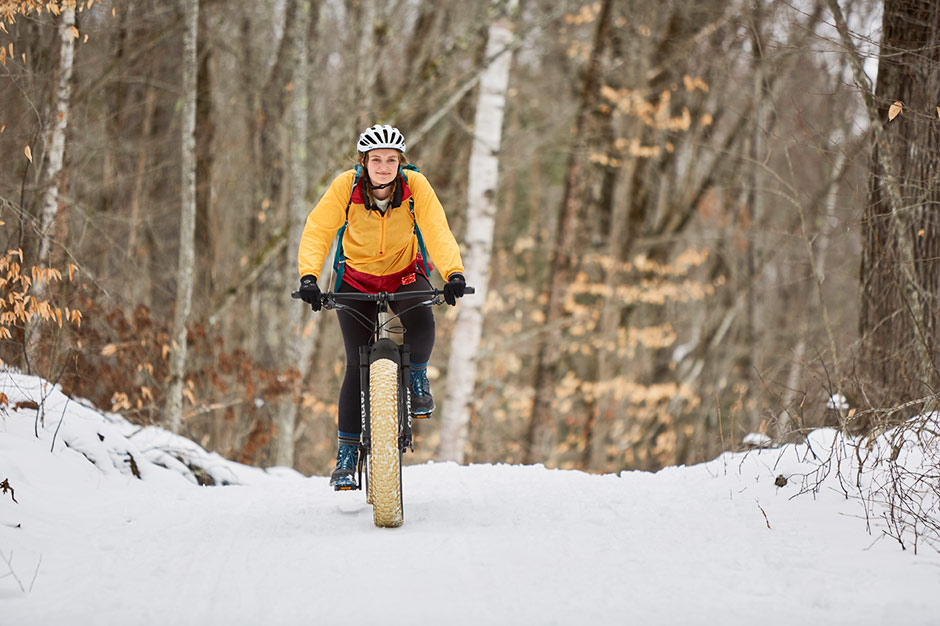
It became clear that efficiency, speed, and miles covered were clearly not the point of fat bikes—no, it was simply for the joy of riding where bikes don’t belong. It was about the squeals of elation and rush of endorphins after saving a front-wheel skidding out of control on a soft snowy corner, it was about floating over the uneven terrain like an old boat of a Cadillac floats over a bumpy road. Even in crashing it was fun—there weren’t the risks of high-speed mountain bike or road bike crashes, and the whole environment was covered in a soft blanket of snow—when I felt the bike slipping beneath me at 5mph I was able to bail into the soft snowbank on the side of the trail.
For us, fat biking was an amazing experience. Having grown up on skis, skates, and snowshoes since we were young kids, this was our first time learning a new winter sport in 20+ years. The beauty of it is that anyone who knows how to ride a bike can pick it up quickly and get out there and give it a try, yet it became immediately obvious that mastering the technique of fat biking would require multiple winters spent in the saddle. Given the proximity of trails, and ease of renting bikes, I think everyone should get out there and give it a try!
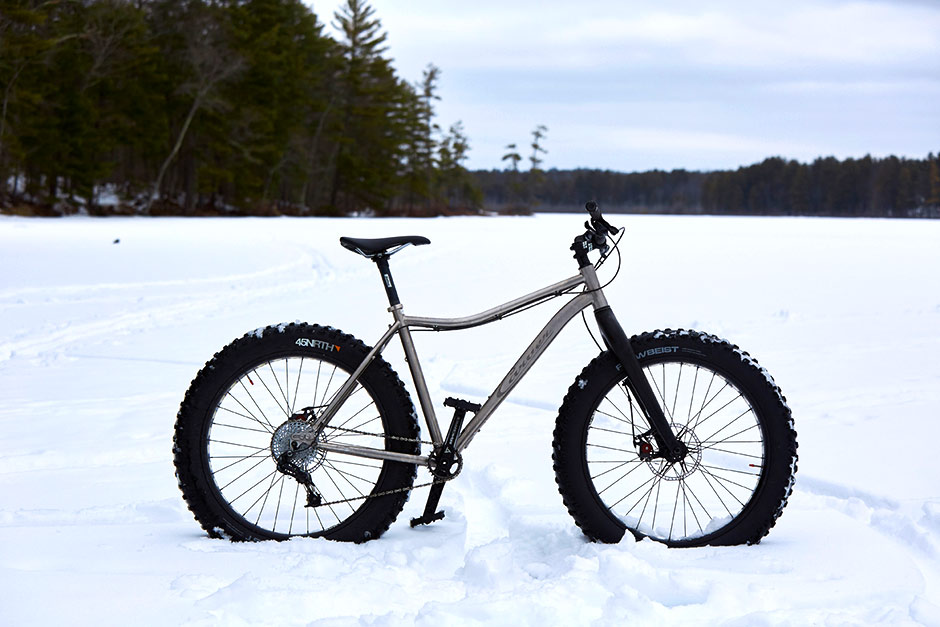
Quick Start Guide to Fat Biking in Midcoast Maine
What to Wear:
Like any aerobic winter activity, when fat biking, you’ll have to balance the cold outside temperatures with your own propensity to heat up while being active. Clothes that help wick sweat away from your body are helpful, as nothing chills your body more than getting sweaty and then zipping downhill on a bike! You’ll want to dress similarly to how you’d cross country ski—wool or synthetic base layers, a fleece, maybe a windbreaker or soft-shell jacket, pants or tights, and wool socks! Waterproof shoes are also great as you’ll undoubtedly be putting your feet down in the snow—we wore waterproof hiking boots, but snow boots would also work, especially on a colder day. If you think you might be out there for a while, a backpack with some extra layers, a few snacks and some water is great too.
Where to Rent Bikes:
We couldn’t have been happier with our Carver bikes from Bath Cycle and Ski, and would definitely recommend them, but they aren’t your only option. Here is a list of places that rent fat bikes in the midcoast region:
Bath Cycle & Ski
115 Main St, Woolwich, ME 04579
www.bikeman.com
Gorham Bike & Ski
88 Union St, Brunswick, ME 04011
www.gorhambike.com
Sidecountry Sports
Limited Selection of adult fat bikes, multiple children’s fat bikes.
481 Main St, Rockland, ME 04841
sidecountrysports.com
Midcoast Conservancy Snow Days at HVNC
Winter Saturdays at Hidden Valley Nature Center 12-4, weather permitting.
131 Egypt Rd, Jefferson, ME 04348
midcoastconservancy.org
CG Bikes
39 Main St, Belfast
207 218-1206
www.cgbikesmaine.com
Where to Ride:
I’m sure there are countless trails known to locals that I’m missing here, but this list should provide some options to get you out on the trails!
Hidden Valley Nature Center
Jefferson, ME 04348
Neptune Woods
Brunswick, ME 04011
Lilly Pond Community Forest
Bath, ME 04530
WhiskeagTrail
Bath, ME 04530
Camden Hills State Park
Camden, ME 04843
Camden Snow Bowl
Camden, ME 04843
Belfast Rail Trail
Belfast, ME







